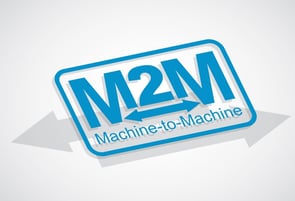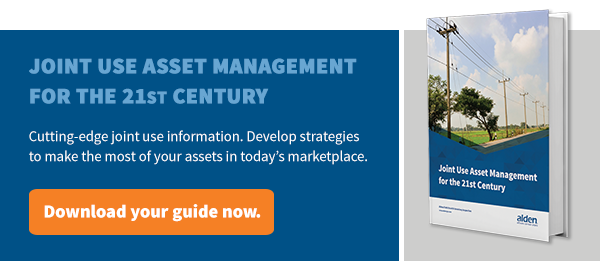Machine-to-Machine Communication and Network Asset Management
 As the Internet of Things (IoT) continues to gain momentum, more and more assets will be connected in the field. Advances in technology mean that internet-aware devices—such as sensors and other data capture technology—are becoming increasingly less expensive. This will enable these devices to be placed in the field to monitor and communicate data related to poles, towers, conduit. Virtually, any field asset.
As the Internet of Things (IoT) continues to gain momentum, more and more assets will be connected in the field. Advances in technology mean that internet-aware devices—such as sensors and other data capture technology—are becoming increasingly less expensive. This will enable these devices to be placed in the field to monitor and communicate data related to poles, towers, conduit. Virtually, any field asset.
In the not-so-distant future, joint use equipment will likely become capable of remote data capture and "talking back" to the plant. This kind of communication will enable automatic alerts to be issued when equipment is in need of maintenance. Field work can become much more efficient when equipment is capable of self-diagnosis.
The concept of using internet-aware devices in the field to transfer data between each other and to other data collection locations is often referred to as machine-to-machine communication or M2M.
How Does Machine-to-Machine Communication Work?
Today, most field work is performed by technicians who travel to the asset in the field to conduct inspection, repair, maintenance or make-ready work. Many technicians use wifi-enabled devices to communicate data about the asset back to their network. However, in the future, the technician will not require a device to record information about a pole or other field asset. Sensors placed on the assets will record, collect and transmit data to each other and other devices. This idea revolves around a mesh network—a network in which devices transmit data between each other.
A mesh network is more cost-effective and uses significantly less energy than traditional networks because they do not need to transmit over long distances. For example, a sensor on one utility pole will transmit its data to the next pole, which will combine that with its own data and transmit all of it back to the plant engineers. Every few houses, a smart reader hub collects the data from local area sensors and transmits to the next hub. This continues until the data reaches the asset owner. Because the sensors only need to transmit a short distance, they can be operated with minimal power usage.
While these sensors will likely begin as small devices that can be attached to poles, towers conduit and other field assets, we imagine that future equipment will be manufactured with built-in sensors designed to help asset owners answer specific questions about the plant in real-time.
Real-Life Examples: What Machine-to-Machine Technology Could Mean for Joint Use
These ideas are complex, and while they are still future possibilities, the technology to enable them is quickly becoming more realistic. The exciting potential for smart joint use equipment, machine-to-machine (M2M) technology and mesh networks is that they can make joint use, and really all field asset management, more efficient and more effective.
Technicians would only be sent out into the field when the data showed a specific repair needed to be made or an issue needed to be investigated. The quantity of exploratory trips to the field would be reduced significantly. The end result is an easier path to profitable joint use businesses.
To help you envision the potential for sensors on field equipment, let’s take a look at the few ways we can imagine this technology could work out in the field:
- Location Sensor: A smart device on a jointly-used asset, such as a utility pole, can identify where it is, using GPS or a communications network to triangulate its location. It could know, "I am attached at this location." The asset owner would no longer need a field visit to capture or verify that data.
- Elevation Sensor: Using three dimensions, a sensor could capture data regarding how high off the ground a piece of equipment is attached to the pole. No one would need to conduct a visual inspection to determine this data.
- Tilt Sensor: Using a gyroscope-type sensor, utility poles could self-report if they become damaged and are leaning as a result of a storm, an accident, or another impact. This shifts repairs to a proactive function, rather than waiting unknowingly until service is interrupted or until a customer calls to report a leaning pole.
- Moisture Sensor: A sensor placed on a pole could collect data on the moisture content of the wood. Rather than waiting for a field inspection, the asset owner could identify aging poles on which rot is increasing the moisture content.
- Heat Sensor: Placed on a transformer, a heat sensor could identify the early signs of poor insulation or transformer failure. Proactive replacement could prevent service interruption and potential damage.
- Safety Sensors: Currently, many utility companies classify poles to identify whether or not they are safe to climb. Using self-reporting sensors, this data could be communicated to the field technician more quickly than putting a tag on the pole that has to be visually seen.
Where To Start: How Companies Can Begin to Take Advantage of M2M Technology for Field Asset Management
As field asset owners, especially joint use asset owners, begin to think about the future of the industry, there is a simple way to dip your toes into machine-to-machine technology. The very first step should be to consider what the one most critical data point is for your business. What question do you want to answer about your field assets?
It can start out simply with, "Which poles should I inspect for rot?" or "Which poles need to be replaced?" or "Which poles are leaning due to high winds?" Every company will have a different data point that has the most impact on their bottom line and operations. Answer that question, and you have your starting point.
Next, you could begin to investigate what sensor technology already exists to measure that data point. While sensors are not generally being marketed specifically for use by joint use asset owners, these kinds of sensors are available. Yet without a well-defined path, it may be helpful to engage a third party to help you identify the right technology and develop an integration plan that coordinates with your communications plan. Talk to us.
Learn more about the future of joint use, and strategies for positioning your business for future success, by downloading Alden's eBook, Joint Use Asset Management for the 21st Century.

Comments